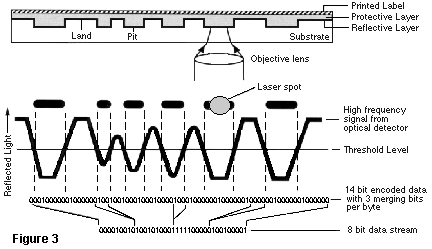

|
Microscopic pits representing encoded data are first formed by exposing photo-resist material with a laser beam. This beam is modulated according to the input source data.
After the exposed areas are developed away by conventional methods to produce pits, a rigid metal negative to the master, called the Father or Master stamper, is produced by an electoplating process (see Figure 2). Multiple positive image Mother may be electroplated from the Father stamper. In turn, negative image Son stampers are plated from each Mother to produce multiple copies of the original master. Mass replication of the source begins by mounting a Father or Son in a molding press. Melted plastic is injected into the cavity and allowed to cool. The pits from the stamper are accurately reproduced in a plastic substrate, forming the original positive image. Each disc is finished by successively applying a reflective layer, protective lacquer, and printed labeling (see Figure 3).
|
The pits which are formed during the mastering and molding processes are read by a small optical system which includes a laser and an optical detector.
The disc and corresponding pit structures rotate under the laser beam during playback. The pits cause the amount of reflected light traveling from the disc to the detector to fluctuate, creating a high frequency signal. The drive determines points in time where this signal crosses a certain threshold value. These crossings, signifying a logical "1", occur at each pit edge.

Due to physical limitations of pit size, it is necessary to maintain at least two "0"s between each "1". An encoding scheme called Eight-to-Fourteen Modulation (EFM) translates every 8 bit combination to a 14 bit code to be written to the disc. Three merging bits are used between each byte to further ensure the separation of "1"s.